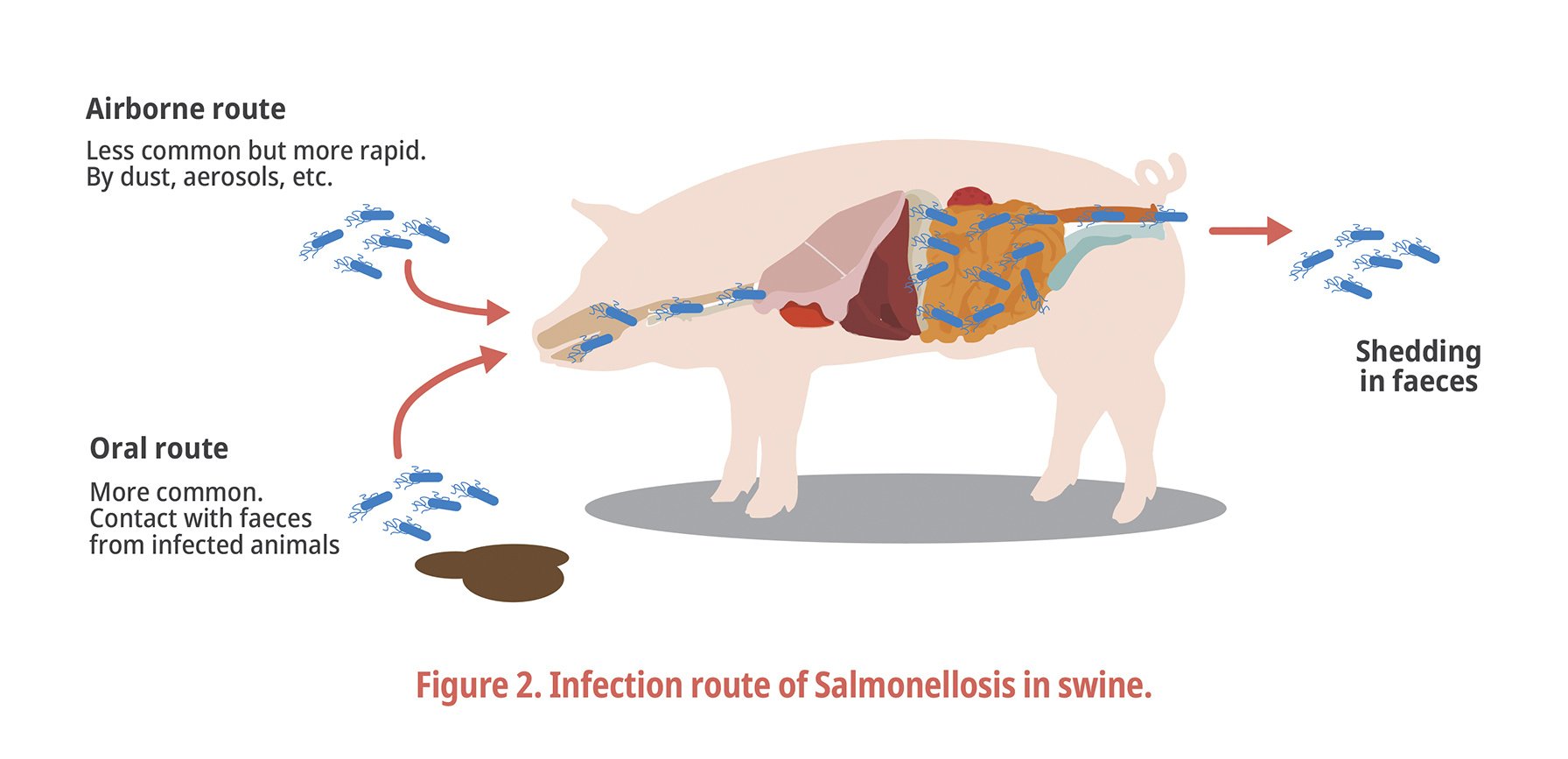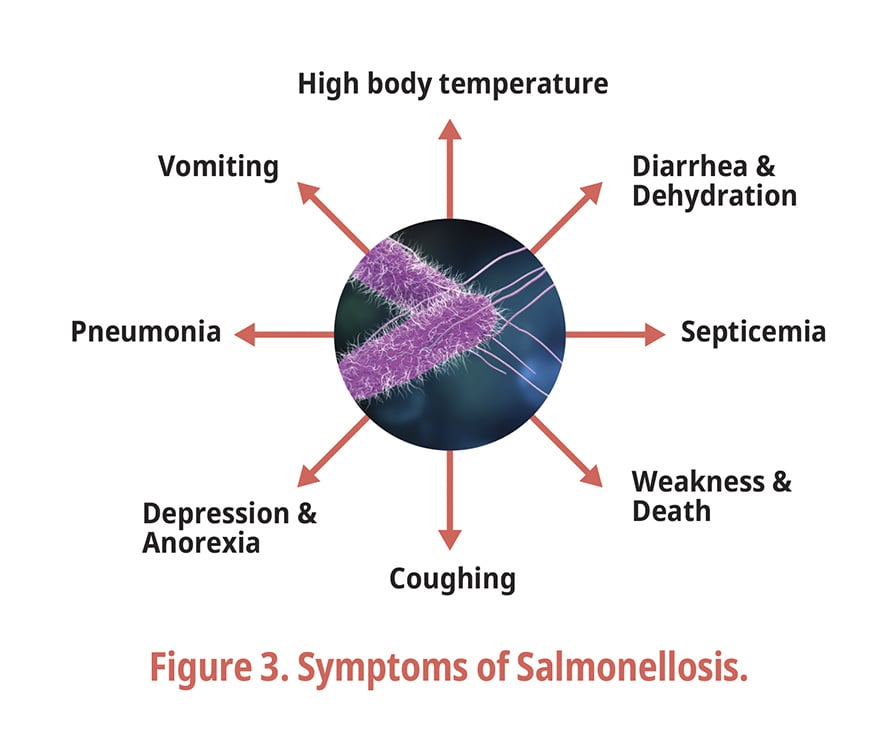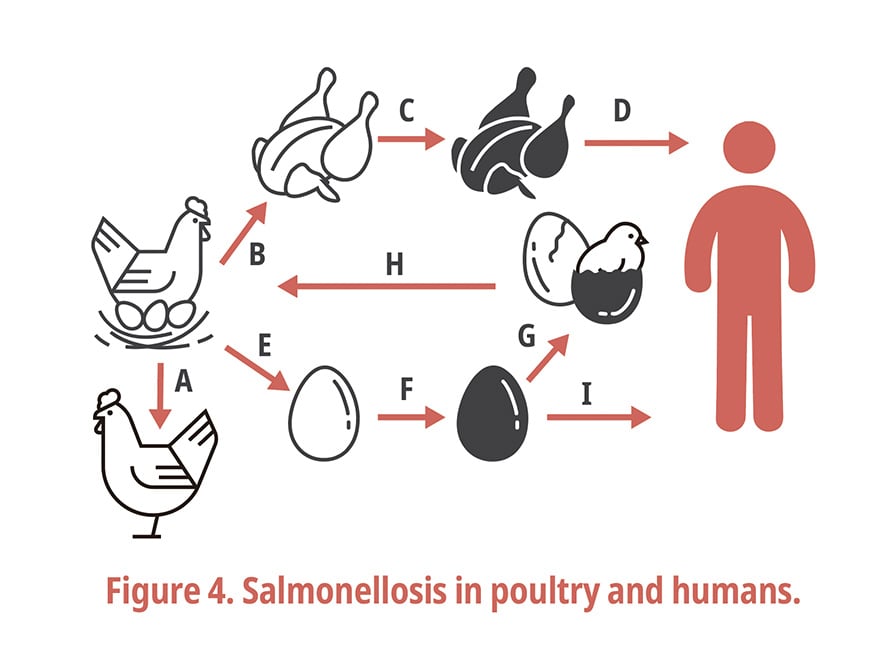Salmonellosis in animals
2020.07.21

INTRODUCTION
Salmonella enterica subspecies enterica (Fig. 1) can be separated into more than 2,400 antigenically different serotypes. The greater number of incidents of salmonellosis in humans and livestocks originated from relatively few serotypes. Salmonella has long been recognized as an important zoonotic pathogen causing food-borne disease throughout the world. Salmonella infections occur in both domestic and wild animals. The common reservoir of Salmonella is the intestinal tract (Fig. 2). Therefore, Salmonella is usually present in feces excreted by animals and often contaminates animal origin products through fecal contact during production and slaughter. For that reason, they are called as carrier animals.


Salmonella infections usually cause enteritis and diarrhea (Fig. 3). The bacteria can also aggress the body to cause septicemia and this aggression result in fever that commonly accompanies the enteritis caused by Salmonella infection. The affected animals are lethargic and do not eat. Very young, old, or immune-suppressed animals can be seriously affected by dehydration associated with diarrhea, develop septicemia or even die. In the case of survival, diarrhea may be seen for a while, but any recovering animal may be a carrier for various times. The bacteria can live in the intestinal lining, lymph nodes, and lymphoid areas such as the bird's ceca. This continuation of survival can also lead to the recurrence of Salmonella infections when the animal suffers from other diseases.

Salmonella infections in poultry
(A) Horizontal transfer of Salmonella between chickens occurs when virulent bacteria shed in the feces are ingested by feeding birds. (B) Only a small percentage of chickens entering processing plants are Salmonella-positive. (C) Up to 50% of carcasses become contaminated (indicated by cross-hatching) during processing. (D) Human infection occurs upon consumption of contaminated meat. (E) Transmission of Salmonella from hens to eggs. (F) The incidence of Salmonella-contaminated eggs (indicated by cross-hatching) increases greatly in the hatching cabinet and (G) within the first day after hatching. (H) Salmonella-infected chicks mature into infected adult birds. (I) Transfer of Salmonella to humans occurs upon consumption of contaminated eggs.

Poultry is one of the largest reservoir of Salmonella and significant risk to public health through consumption of contaminated eggs and meat (Fig. 4). Poultry products are frequently identified as important sources of Salmonella that cause human diseases. Eating contaminated eggs or chicken have been identified as a significant risk factor for S. Enteritidis infection [1]. Many of the serotypes that are most prevalent in humans such as S. Typhimurium and S. Enteritidis are also commonly found in poultry [2].
Poultry has many sources of infection including vertical transmission, contaminated feed and the environment. Asymptomatic excretion of Salmonella in the intestine causes the contamination of eggs in vertical transmission. As soon as hatching, oral ingestion by the chick or poult can result in large numbers of Salmonella entering the intestine and feces. This causes a rapid horizontal spread through the hatchery [3]. Poultry can be infected with a variety of Salmonella serotypes, mainly localized in the gastrointestinal tract with fecal excretion [4].
There are four diseases induced by Salmonella in poultry such as pullorum disease caused by Salmonella enterica serotype Pullorum, fowl typhoid (FT) caused by S. Gallinarum, arizonosis caused by S. enterica subsp. arizonae and paratyphoid caused by several serotypes and subspecies of Salmonella most particularly S. Typhimurium, S. Enteritidis, S. Infantis to name a few [4]. The pullorum disease (PD) caused by S. enterica serotype Pullorum, is egg transmitted and occurs primarily in the first few days of life, many dead-in-shell chicks are seen (white bacillary diarrhea). Fowl typhoid (FT) is a disease caused by S. enterica serotype Gallinarum, which is usually transmitted by the oro-fecal route and mainly affects adult birds [3]. The first incidence of FT was characterized by high mortality, especially during the first two months of the outbreak [4]. Arizonosis caused by . enterica subsp. arizonae is an egg-transmitted infection mainly of young poultry, still sporadic in commercial flocks, can infect and induce disease in chickens or other species of birds. The bacteria is present in the ovary and oviduct of adult breeders and the chicks and poults hatched from infected breeders develop the disease. The disease is described by diarrhea with pasting feces in the cloaca, anorexia and elevated levels of mortality can be observed up to 50% [5].
Fowl paratyphoid caused by several non-host-specific Salmonella is an acute or chronic disease in poultry or mammalian species. The highest morbidity and mortality are usually observed during the first two weeks after hatch. Paratyphoid infections are important for public health through contamination and mishandling of poultry products. Salmonella enterica serotype Typhimurium, S. enterica Enteritidis, S. enterica Kentucky, and S. enterica Heidelberg are known as the most common reasons of Salmonella infections in poultry. Salmonella enterica serotype Typhimurium is mainly known to induce clinical salmonellosis in very young birds. Mortality rate range from less than 10% to over 80% in severe outbreaks. Resistance to infection develops rapidly during the first 72 hours of life, and has been attributed to maturation of macrophages and the development of a commensal flora in the gut leading to competitive exclusion of Salmonella [4]. The strains of S. enterica serotype Enteritidis are also highly virulent for young chicks [6]. Salmonella enterica serotype Enteritidis, and in particular strains of phage type 4 (PT4) can also cause asymptomatic and chronic infections in older birds including commercial layers and broiler breeders [7-9]. Epidemiological data show a clear association between food borne illness caused by serotype Enteritidis PT4 and the consumption of undercooked eggs [10]. Salmonella enterica serotype Enteritidis infections are mostly seen in fresh shelled eggs and egg products, in which the bacteria contaminate the interior components of the egg through transovarial infection. Salmonella enterica serotype Enteritidis infects the ova or oviduct of the hens reproductive tract, which causes contamination of the albumen, vitelline membrane and possibly the yolk.
Salmonella infections in pigs
The organism, now known as Salmonella enterica serotype Choleraesuis, was first isolated from pigs when it was considered the cause of swine fever (hog cholera) [11]. The ability of Salmonella to cause disease in pigs depends on number of factors including the infected serotype and the age of the pig. Regional variation in occurrence of salmonellosis is loosely correlated to pig density, husbandry practices and co-mingling of pigs [4].
The Salmonella serotypes associated with clinical disease in pigs can be divided into two groups: the host-restricted serotypes represented by S. Choleraesuis and the ubiquitous serotypes represented by S. Typhimurium. The presence of S. Choleraesuis has sharply declined and is now only isolated sporadically. It was later understood that a diversity of antigenically distinct S. enterica serotypes can be isolated from pigs, some of which are of zoonotic as they transmitted to humans through the food chain and farm environment, where they typically cause acute but self-limiting gastroenteritis [12]. Salmonella enterica serotype Typhimurium is the most common serotype isolated from pigs. Likewise, S. Derby is strongly linked with pigs on both sides of the Atlantic Ocean, and is recognized as the second most common serotype in pigs. It is thought that oral intake is an important route of infection as a large amount of Salmonella are shed through feces of clinically infected pigs.
Aspiration of infected material into the upper respiratory tract is another possible route of infection. Pneumonia is a common feature of swine S. Choleraesuis infections [13]. Several studies have shown that pigs can be experimentally infected by intranasal inoculation. Pigs infected with S. Choleraesuis through the intranasal route experience more severe clinical signals than those infected through the oral route [14]. These observations indicate that the tonsils and lungs are important sites of invasion. Clinical salmonellosis in pigs is standardly of two forms; septicemia caused by host-restricted S. enterica serotypes such as Choleraesuis, and enterocolitis originated by wide host-restricted serotypes such as Enteritidis. Unsurprisingly, weaned pigs that are intensively reared are more at risk to be affected by Salmonella infections.
Like other host-specific serotypes, S. Choleraesuis can induce disease in both young and older animals, whereas S. Typhimurium typically lead to disease in pigs aged between 6 and 12 weeks of age, but seldom in adult animals. In older animal, subclinical infections with S. Typhimurium are frequent, leading to high transmission rates if active carrier animals are not detected. Salmonella enterica serotypes Choleraesuis typically cause septicemic forms of infection. Salmonella enterica serotypes Typhimurium typically causes enterocolitis [3].
CONCLUSION
Regulation is strengthening on meat production in many countries. Rearing of animals in unsanitary environments combined with insufficient control measures result in the transmission of many microorganisms including Salmonella. Salmonella has been recognized as a major zoonotic pathogen causing food-borne disease across the world. Unfortunately, many aspects of Salmonella are still unresolved despite significant amount of research aimed to control this microorganism. Therefore, it is imperative that Salmonella should continue to remain an important concern worldwide regarding research activity.






